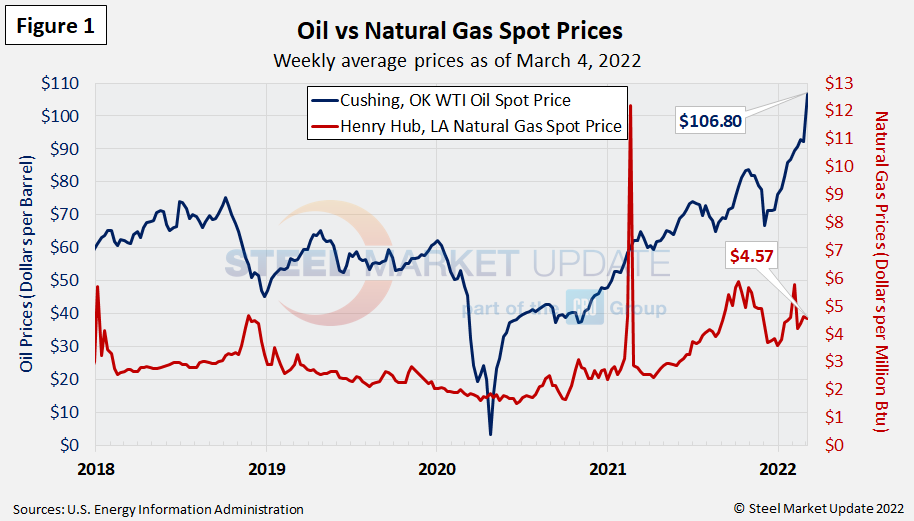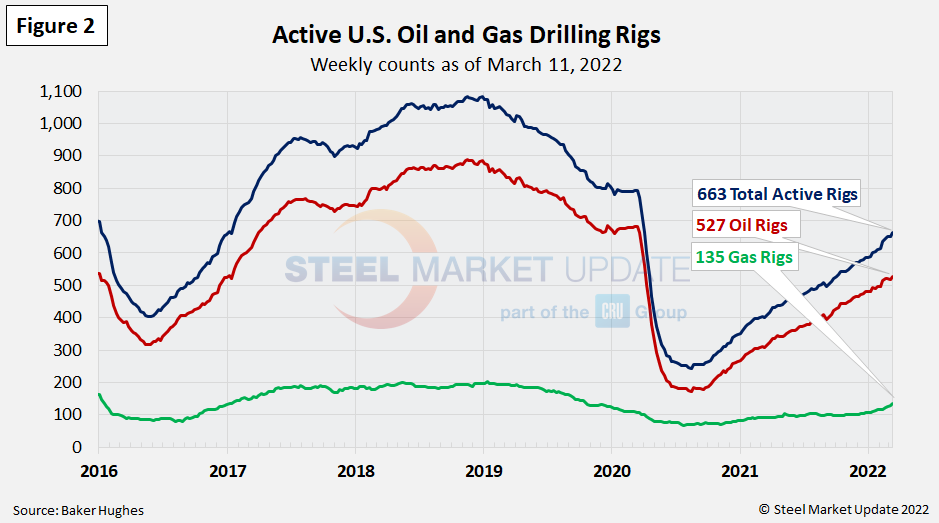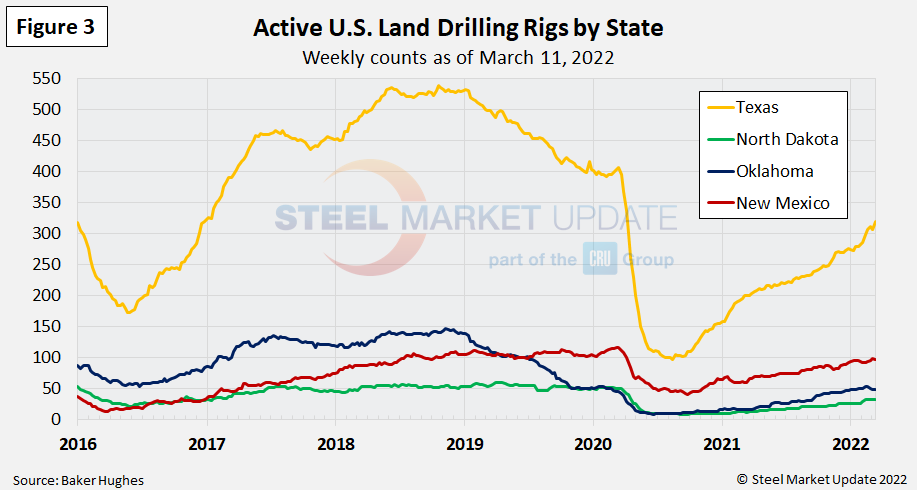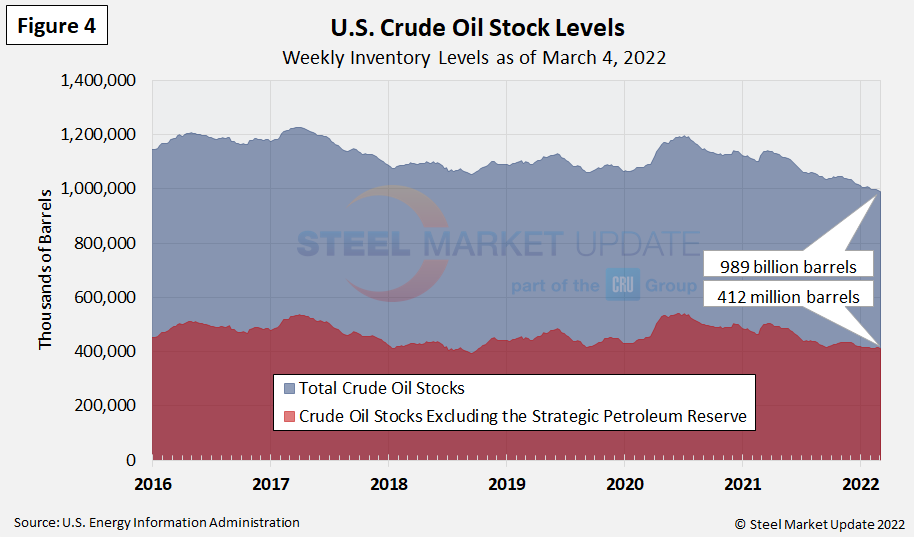Environment and Energy

Energy Market Analysis through March
Written by Brett Linton
March 15, 2022
The Energy Information Administration’s March Short-Term Energy Outlook (STEO) is subject to an even higher level of uncertainty than usual due to Russia’s invasion of Ukraine. As EIA’s latest report explains, “supply uncertainty results from the conflict in Ukraine, the production decisions of OPEC+, and the rate at which U.S. oil and natural gas producers increase drilling.” Regarding price forecasts, the EIA warns “actual outcomes will be dependent on the degree to which existing sanctions imposed on Russia, any potential future sanctions, and independent corporate actions affect Russia’s oil production or the sale of Russia’s oil in the global market.”
Spot Prices
The spot market price for West Texas Intermediate (WTI) was at $106.80 per barrel as of March 4 (Figure 1), now the highest weekly price since June 2014. The EIA report notes: “Daily spot prices for Brent closed at almost $124/b in the first week of March as the further invasion of Ukraine by Russia and subsequent sanctions on Russia and other actions created significant market uncertainties about the potential for oil supply disruptions. These events are occurring against a backdrop of low oil inventories and persistent upward oil price pressures…. We expect the Brent price will average $117/b in March, $116/b in 2Q22, and $102/b in the second half of 2022 (2H22). We expect the average price to fall to $89/b in 2023. However, this price forecast is highly uncertain.”
Natural gas prices have eased since SMU’s last update, now at $4.57 per MMBTU (million British Thermal Units) as of March 4. Recall that back in October, natural gas spot prices had reached a 7.5-year high of $5.87 per MMBTU (we are excluding the high spot-prices seen in February 2021 due to winter storms and supply scarcity). In early-February, prices neared that high again, reaching $5.78 per MMBTU. EIA expects natural gas prices to average $4.10 per MMBTU in March, falling to an average of $3.83 in the second quarter, and averaging $3.95 across 2022. EIA forecasts natural gas prices to average $3.59 per MMBtu in 2023.

Rig Counts
The number of active U.S. oil and gas drill rigs continues to slowly recover from the mid-2020 low. The latest count was 663 active drill rigs as of the end of last week, comprised of 527 oil rigs, 135 gas rigs, and 1 miscellaneous rig, according to Baker Hughes (Figure 2). Active drill rigs are still down 16% from the 793 count in March 2020, just prior to the coronavirus shutdowns. EIA expects rig counts to increase into 2022 as oil production rises in the U.S. The table below compares the current U.S., Canadian and international rig counts to historical levels.


U.S. oil and gas production are heavily concentrated in Texas, Oklahoma, North Dakota and New Mexico. As of March 4, production is steadily increasing, but still down as much as 35% compared to pre-COVID levels. The most active state, Texas, now has 319 rigs in operation, the highest level seen since April 2020. Recall that Texas rigs had plummeted 76% back in 2020, falling from 407 in March to 97 rigs in August (Figure 3).

Stock Levels
U.S. total crude oil stocks continue to decline from the mid-2020 high, reaching a new 13.5-year low of 989 million barrels as of March 4. This time last year stocks were at 1.136 billion barrels (Figure 4).

Trends in energy prices and rig counts are a predictor of demand for oil country tubular goods (OCTG), line pipe and other steel products.
By Brett Linton, Brett@SteelMarketUpdate.com

Brett Linton
Read more from Brett LintonLatest in Environment and Energy

Global Steel Climate Council certifies eight SDI, ASA HR products
GSCC certifies eight products from Steel Dynamics and Arkansas Steel Associates.

June energy market update
In this Premium analysis we examine North American oil and natural gas prices, drill rig activity, and crude oil stock levels. Trends in energy prices and rig counts serve as leading indicators for oil country tubular goods (OCTG) and line pipe demand.

EPA deregulation proposals win praise from steel advocates
Two industry groups are applauding two EPA proposals that would support domestic steel production.

Met coal receives critical materials status
The US Department of Energy (DOE) adds metallurgical coal to the nation’s list of Critical Materials, following its designation by US Secretary of Energy, Chris Wright’s announcement on May 22.

May energy market update
An analysis of the North American energy market in May.
